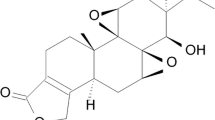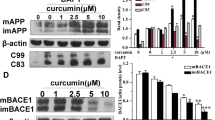Abstract
Alzheimer’s disease (AD) is a neurodegenerative disorder that affects the elderly population. Deposition of beta-amyloid (Aβ) in the brain is a hallmark of AD pathology. In our previous study, we have constructed a cell line expressing human APP695 (hAPP695) in SH-EP1 cells stably transfected with human nicotinic receptor (nAChR) α4 subunit and β2 subunit gene. In present study, we found that activation of α4β2 nAChR by nicotine and epibatidine decreased secreted Aβ level in the cell line and hippocampal neurons, but had no effects on full-length APP695 and sAPP-α. Nicotine also decreases BACE1 and PSEN1 expression, as well as ERK1 and NFκB P65 subunit expression in the cell line. Furthermore, BACE1 promoter activity is, but PSEN1 not, decreased by nicotine in the cell line. All the results suggest that activation of α4β2 nAChR decreases Aβ through regulating BACE1 transcription by ERK1-NFκB pathway. Additionally, analysis of BACE1 promoter activity by dual-luciferase reporter assay may be useful for drug screening as a high throughput method.








Similar content being viewed by others
References
Meyer-Luehmann M, Spires-Jones TL, Prada C et al (2008) Rapid appearance and local toxicity of amyloid-beta plaques in a mouse model of Alzheimer’s disease. Nature 451:720–724
Koffie RM, Meyer-Luehmann M, Hashimoto T et al (2009) Oligomeric amyloid beta associates with postsynaptic densities and correlates with excitatory synapse loss near senile plaques. Proc Natl Acad Sci USA 106:4012–4017
Masters CL, Simms G, Weinman NA et al (1985) Amyloid plaque core protein in Alzheimer diseaseand Down syndrome. Proc Natl Acad Sci USA 82(12):4245–4249
Turner PR, O’Connor K, Tate WP et al (2009) Roles of amyloid precursor protein and its fragments in regulating neural activity, plasticity and memory. Prog Neurobiol 70:1–32
Vassar R (2004) BACE1: the beta-secretase enzyme in Alzheimer’s disease. J Mol Neurosci 23(1–2):105–114
Vassar R, Bennett BD, Babu-Khan S et al (1999) Beta-secretase cleavage of Alzheimer’s amyloid precursor protein by the transmembrane aspartic protease BACE. Science 286(5440):735–741
Yang LB, Lindholm K, Yan R et al (2003) Elevated beta-secretase expression and enzymatic activity detected in sporadic Alzheimer disease. Nat Med 9:3–4
Zhao J, Fu Y, Yasvoina M et al (2007) Beta-site amyloid precursor protein cleaving enzyme 1 levels become elevated in neurons around amyloid plaques: implications for Alzheimer’s disease pathogenesis. J Neurosci 27:3639–3649
Zhang XM, Cai Y, Xiong K et al (2010) β-Secretase-1 elevation in transgenic mouse models of Alzheimer’s disease is associated with synaptic/axonal pathology and amyloidogenesis: implications for neuritic plaque development. Eur J Neurosci 30:2271–2283
Stockley JH, O’Neill C (2008) Understanding BACE1: essential protease for amyloid-beta production in Alzheimer’s disease. Cell Mol Life Sci 65(20):3265–3289
Zhang LJ, Xiao Y, Qi XL et al (2010) Cholinesterase activity and mRNA level of nicotinic acetylcholine receptors (alpha4 and beta2 Subunits) in blood of elderly Chinese diagnosed as Alzheimer’s disease. J Alzheimers Dis 19(3):849–858
Arneric SP, Arneric SP, Holladay M et al (2007) Neuronal nicotinic receptors: a perspective on two decades of drug discovery research. Biochem Pharmacol 74(8):1092–1101
Gotti C, Riganti L, Vailati S et al (2006) Brain neuronal nicotinic receptors as new targets for drug discovery. Curr Pharm Des 12(4):407–428
O’Neill MJ, Murray TK, Lakics V et al (2002) The role of neuronal nicotinic acetylcholine receptors in acute and chronic neurodegeneration. Curr Drug Targets CNS Neurol Disord 1:399–411
Cincotta SL, Yorek MS, Moschak TM et al (2008) Selective nicotinic acetylcholine receptor agonists: potential therapies for neuropsychiatric disorders with cognitive dysfunction. Curr Opin Investig Drugs 9(1):47–56
Nitsch RM, Slack BE, Wurtman RJ et al (1992) Release of Alzheimer amyloid precursor derivatives stimulated by activation of muscarinic acetylcholine receptors. Science 258(5080):304–307
Nie H, Li Z, Lukas RJ et al (2008) Construction of SH-EP1-alpha4beta2-hAPP695 cell line and effects of nicotinic agonists on Beta-amyloid in the cells. Cell Mol Neurobiol 28(1):103–112
Kaech S, Banker G (2006) Culturing hippocampal neurons. Nat Protoc 1(5):2406–2415
Ge YW, Ghosh C, Song W et al (2004) Mechanism of promoter activity of the Beta-amyloid precursor protein gene in different cell lines: identification of a specific 30 bp fragment in the proximal promoter region. J Neurochem 90(6):1432–1444
Caterina MH, Rakez K, Hui Z et al (2010) Loss of α7 Nicotinic Receptors Enhancesβ-Amyloid Oligomer Accumulation, Exacerbating Early-Stage Decline and Septohippocampal Pathology in a Mouse of Alzheimer’s Disease. J Neurosci 30(7):2442–2453
Caccamo A, Fisher A, LaFerla FM (2009) M1 agonists as a potential disease-modifying therapy for Alzheimer’s disease. Curr Alzheimer Res 6(2):112–117
Neugroschl J, Sano M (2010) Current treatment and recent clinical research in Alzheimer’s disease. Mt Sinai J Med 77(1):3–16
Paterson D, Nordberg A et al (2000) Neuronal nicotinic receptors in the human brain. Prog Neurobiol 61:75–111
Cincotta SL, Yorek MS, Moschak TM et al (2008) Selective nicotinic acetylcholine receptor agonists: potential therapies for neuropsychiatric disorders with cognitive dysfunction. Curr Opin Investig Drugs 9:47–56
Tamagno E, Guglielmotto M, Aragno M et al (2008) Oxidative stress activates a positive feedback between the gamma- and beta-secretase cleavages of the Beta-amyloid precursor protein. J Neurochem 104(3):683–695
Tomizawa M, Casida JE (2002) Desnitro-imidacloprid activates the extracellular signal-regulated kinase cascade via the nicotinic receptor and intracellular calcium mobilization in N1E–115 cells. Toxicol Appl Pharmacol 184(3):180–186
Chen RJ, Ho YS, Guo HR et al (2010) Long-term nicotine exposure-induced chemoresistance is mediated by activation of Stat3 and downregulation of ERK1/2 via nAChR and beta-adrenoceptors in human bladder cancer cells. Toxicol Sci 115(1):118–130
Rahman A, Anwar KN, Minhajuddin M et al (2004) cAMP Targeting of p38 MAP Kinase Inhibits Thrombin-induced NF-{kappa}B Activation and ICAM-1 Expression in Endothelial Cells. Am J Physiol Lung Cell Mol Physiol 287(5):L1017–L1024
Memet S (2006) NF-kappaB functions in the nervous system: from development to disease. Biochem Pharmacol 72(9):1180–1195
Bourne KZ, Ferrari DC, Lange-Dohna C et al (2007) Differential regulation of BACE1 promoter activity by nuclear factor-kappaB in neurons and glia upon exposure to Beta-amyloid peptides. J Neurosci Res 85(6):1194–1204
Tamagno E, Guglielmotto M, Giliberto L et al (2009) JNK and ERK1/2 pathways have a dual opposite effect on the expression of BACE1. Neurobiol Aging 30(10):1563–1573
Virginie BP, Jean S, Steffen R et al (2008) NFkappaB-dependent control of BACE1 promoter transactivation by Abeta42. J Biol Chem 283(15):10037–10047
Acknowledgments
This work was supported by the grant from the Shanghai Committee of Science and Technology, China (Grant No. 08431900600), the grant from the National Comprehensive Technology Platforms for Innovative Drug R&D, China (2009ZX09301–007), the national natural science foundation of China (No. 30572179, 30672443), and financial support from China postdoctoral science foundation(20090450709). We thank Dr. Ronald J. Lukas for SH-EP1 cell line.
Author information
Authors and Affiliations
Corresponding author
Rights and permissions
About this article
Cite this article
Nie, HZ., Li, ZQ., Yan, QX. et al. Nicotine Decreases Beta-Amyloid Through Regulating BACE1 Transcription in SH-EP1-α4β2 nAChR-APP695 Cells. Neurochem Res 36, 904–912 (2011). https://doi.org/10.1007/s11064-011-0420-7
Accepted:
Published:
Issue Date:
DOI: https://doi.org/10.1007/s11064-011-0420-7




